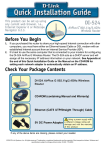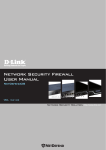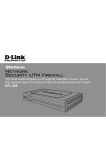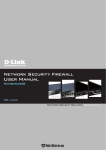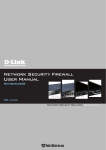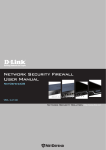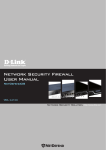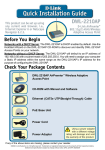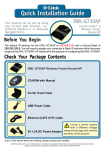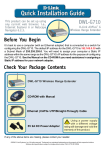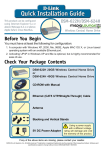Download D-Link DFL-200 User's Manual
Transcript
DFL-200 This product can be set up using an en eb br owser ., anyy curr curren entt W Web browser owser,, i.e i.e., Internet Explorer 6 or Netscape Navi gator 6 or above avigator above.. NETDEFEND™ Network Security Firewall Before You Begin If you purchased this Network Security Firewall to connect to your high-speed Internet connection in a secure manner, you must have either an Ethernet-based Cable or DSL modem with an established Internet account from an Internet Service Provider (ISP). Check Your Package Contents These are the items included with your DFL-200 purchase: DFL-200 NETDEFEND™ Network Security Firewall CD-ROM (containing Manual and Warranty) Ethernet (CAT5 UTP/Straight-Through) Cable Console Cable (RS-232) 5V DC Power Adapter Using a power supply with a different voltage rating will damage this product and void its warranty. If any of the above items are missing, please contact your reseller. ©2004 D-Link Systems, Inc. All rights reserved. Trademarks or registered trademarks are the property of their respective holders. Software and specifications subject to change without notice. DFL-200.10262004 Connecting The DFL-200 Network Security Firewall To Your Network A. Connect the power adapter to the receptor on the back panel of the DFL-200 and then plug the other end of the power adapter to a wall outlet or power strip. The Power LED will turn ON to indicate proper operation. B. Power off your Cable or DSL modem; some devices may not have an on/off switch and will require you to unplug the power adapter. Now, the DFL-200 should be powered on and the Cable / DSL modem should be turned off. Cable / DSL modem (Power Off) – DFL-200 (Power On) C. Attach an Ethernet cable to the Ethernet jack located on the Cable / DSL modem. After the Ethernet cable is securely connected, power on the Cable / DSL modem by turning on the unit or plugging in the power adapter. Cable / DSL modem (Power On) – DFL-200 (Power On) D. Attach the other end of the Ethernet cable to the WAN port on the back panel of the DFL-200. The WAN LED light will illuminate to indicate proper connection. If the WAN LED is not illuminated, please go back to step B and repeat the steps. E. Attach an Ethernet cable to a LAN port on the back panel of the DFL-200 and connect it to a port on your network hub or switch. The LED light for the LAN port on the DFL-200 will illuminate to indicate proper connection. F. Connect the computer that you will use to configure the DFL-200 to the network hub or switch. LAN ports: Connect the local area network. DMZ port: Connects to the DMZ network. COM Port: Connects to your computer’s COM port using the provided Console Cable. WAN port: Connects to the Cable or DSL modem. Power Receptor: Connection for the Power Adapter. 2 Connecting The DFL-200 Network Security Firewall To Your Network (continued) STATUS LED: A solid late may indicate failure. In such case, contact D-Link Technical Support (info on the back page). POWER LED: A solid light indicates a proper connection to the power supply. NETWORK LEDs: A solid light on the port indicates a good connection. The LEDs blink during data transmission. When you have completed the steps in this Quick Installation Guide, your connected network may look similar to this: Ideally the firewall should be placed between your internal network and the Internet. 3 Using The Setup Wizard To obtain a new IP address from the DFL-200 you may need to restart your computer or release and renew your IP address. First make sure that the network adapter in your computer is configured properly. Instructions for configuring the network adapter to obtain an IP address automatically from the DFL-200 can be found in the Appendix. The DFL-200 provides Web based configuration. You can configure your DFL-200 using a Web browser such as Internet Explorer or Netscape Navigator in Windows, Macintosh, or UNIX based environments. Open your Web browser and type http://192.168.1.1 into the URL address box. Then press the Enter or Return key. The IP Address shown in the example above is the default setting. The DFL-200 Connection Wizard only appears upon initial connection to the unit and can be reinvoked by resetting the unit to the factory default settings (Note: Resetting the unit to the factory default settings will erase any changes you have made to the unit). Welcome to the DFL-200 connection wizard! Here you can choose to either configure your firewall over HTTP or over Secure HTTP (HTTPS). Click on Connect to the unit via HTTPS instead to use Secure HTTP Click Next to keep using HTTP 4 Using The Setup Wizard (continued) Step 1 - Set admin password Enter the password that you want to use for the admin account. Click Next Step 2 - Set timezone Select the appropriate timezone Enter the appropriate daylight saving time settings. Click Next Step 3 - Configure WAN interface Select the appropriate configuration for the WAN interface. Click Next and continue to step 4. If unsure of which setting to select, contact your Internet Service Provider. Click Next 5 Using The Setup Wizard (continued) Step 3 - Static IP Enter the IP address information provided to you by your Internet Service Provider. You will need to complete all the required fields except for Secondary DNS Server. Click Next and continue to step 4 Click Next Step 3 - PPPoE Fill out the user name and password provided to you by your Internet Service Provider. The PPPoE Service Name field should be left blank unless your ISP informs you otherwise. Click Next and continue to step 4 Click Next 6 Using The Setup Wizard (continued) Step 3 - PPTP Specify both PPTP tunnel parameters and Physical interface parameters. PPTP tunnel parameters: Enter the Username, Password and the PPTP Server IP address provided by your ISP. Physical interface parameters. DHCP: If your Internet Service Provider is using DHCP you should select the DHCP radio button. Static IP: If your Internet Service Provider is using Static IP you should select the Static IP radio button and enter IP Address, choose a Subnet Mask and enter the Gateway IP address. Click Next Step 3 - Big Pond Fill out the user name and password provided to you by your ISP. Click Next and continue to step 4 Click Next 7 Using The Setup Wizard (continued) Step 4 - Set up built-in DHCP server If you want to use the DFL-200’s built-in DHCP Server, choose Enable DHCP Server from this screen. You then need to specify a range of IP addresses to assign the DHCP clients. The range is entered in the format “Start IP – Stop IP” i.e. 192.168.0.100 – 192.168.0.200 or network/subnet mask address in bits, i.e. 192.168.0.0/24. If you don’t want to use the built-in DHCP Server or want to configure it later, choose Disable DHCP Server and click Next. Click Next Step 5 - Configure helper servers NTP Servers - If enabled, specifies which NTP Servers should be used for time synchronization. Syslog Servers – If enabled, specifies the server(s) where system log data is sent. Click Next Setup Wizard Complete Click Restart to complete your configuration. Click Restart 8 Appendix - IP Configuration To connect to the network, make sure the network adapter in your computer is configured properly. Here’s how to configure the network adapter to obtain an IP address automatically from the DFL-200 Network Security Firewall. Microsoft Windows XP: Go to Start > right click on My Network Places > select Properties > Right-click on the Network Connection of the Ethernet adapter connecting to the DFL-200 and select Properties. Click Internet Protocol (TCP/IP) Click Properties Select Obtain an IP address automatically Click OK 9 Appendix - IP Configuration (continued) Apple Mac OS X: Go to the Apple Menu and Select System Preferences. Click on Network. Click on Network Select Built-in Ethernet in the show pull down menu Select Using DHCP in the Configure pull down menu The IP address information, the Subnet Mask, the DFL-200 IP address and the Ethernet adapter address will appear. Click on Apply Now 10 Notes 11 Techni cal Support echnical You can find software updates and user documentation on the D-Link website. D-Link provides free technical support for customers within the United States and within Canada for the duration of the warranty period on this product. U.S. and Canadian customers can contact D-Link technical support through our website, or by phone. Tech Support for customers within the United States: D-Link Technical Support over the Telephone: (877) 453-5465 6am-6pm PST, Mon-Fri. D-Link Technical Support over the Internet: http://support.dlink.com email:[email protected] Tech Support for customers within Canada: D-Link Technical Support over the Telephone: (800) 361-5265 Monday to Friday 7:30am to 12:00am EST D-Link Technical Support over the Internet: http://support.dlink.ca email:[email protected]












